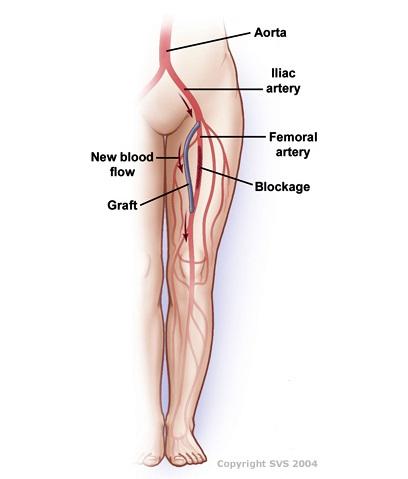What is Surgical Bypass?
In the leg, also called lower extremity bypass, leg bypass, fem-pop bypass, fem-tib bypass, fem-distal bypass.
In the abdomen, also called aortic bypass, aorto-iliac bypass, aorto-femoral bypass, fem-fem bypass, aorto-mesenteric, and ax-fem bypass, depending on which blood vessel is being bypassed.
With the help of a natural or synthetic graft, a surgical bypass routes blood flow around an area of blockage caused by peripheral arterial disease (PAD). The surgery does not cure the disease or remove the blockage. Think of a surgical bypass as a road detour.
How Long It Lasts Varies
The lifespan of a surgical bypass depends on the health of your arteries, the type of graft used (natural vein grafts last longer than synthetic ones) and other health factors, such as whether you smoke, or have diabetes or kidney failure.

A surgical bypass may help you if you have PAD and have symptoms such as leg muscle pain while walking (claudication); pain at night, especially in the feet (rest pain); feet and leg sores that won't heal; and dead tissue (gangrene).
Usually, other therapy is tried first, such as medication, exercise, smoking cessation and wound care. If these fail and alternative treatment such as a balloon angioplasty and stenting is not suitable, then tests may be performed to assess the possibilities of a surgical bypass.
You will be given a general or spinal anesthetic so that you will feel no pain during the operation.
- A fem-pop bypass, the most common type, uses a natural or synthetic graft to create the detour around the blockage beginning at your groin/thigh crease and ending at the inner knee, or sometimes the calf or foot.
- An incision, about 4–5 inches long, is made at the groin crease and again at the end point.
- If your own vein is used to create the graft, other small incisions may be made on the inner portion of the thigh. Otherwise, a synthetic tube made of fabric (Dacron) or plastic (PTFE, Gortex) will be used.
- The graft is sewn to the artery at both ends with fine stitches.
- Surgery can take 1.5–6 hours, depending upon the type and extent of surgery.
For an aortic bypass, a synthetic graft made of fabric (Dacron) or plastic (PTFE, Gortex) is used, and a vertical midline abdominal incision is made. Surgery can take 3–4 hours.

Bypass grafts generally last very well but some can develop problems. They can become narrowed, blocked or their flow can slow from new blockages above or below the bypass.
For this reason, your vascular surgeon will want to continue to see you regularly (1-4 times a year) to check your bypass for problems that can be fixed before it quits completely. This is usually remedied by a minimally invasive procedure or a minor surgical procedure so that a new bypass can be avoided.
Other possible complications soon after surgery include:
- Heart attack, as many patients with PAD also have heart disease.
- Wound infections, though antibiotics are given before and after surgery to help prevent this.
- Bladder or other infections.
- Pneumonia.
- Clotting or blockage of the bypass graft.
When You Agree to Surgery
- If you smoke, stop as soon as possible to lessen the chance of many of the complications.
- If you have a heart doctor (cardiologist), your vascular surgeon may want you to get her/his okay.
- You may need blood tests, an EKG, special x-rays or a heart stress test.
Days Before
- Follow your normal routine and get plenty of sleep.
- Carefully follow instructions about medications the day before and day of surgery.
- You may need to fast (no food or drink) beginning at midnight the day of surgery.
- You will be in the hospital for 2-5 days for monitoring and recuperation, perhaps 7 days if you had an aortic bypass. The bowels often go to sleep for several days after aortic surgery, so food is re-introduced gradually.
- You'll have incision pain/discomfort for several days/weeks, treated with pain medication. Typically, there is swelling and sometimes drainage.
- Sometimes, patients will go to a rehab facility for a few days after leaving the hospital to regain strength.
- When you go home, it is wise (and sometimes required by your vascular surgeon) to have someone stay with you for a few days. Most patients will take a few weeks off from work.
- You will be able to ride in a car and walk up steps, but you will need time to recuperate before driving or doing heavy work - how long depends on your condition and type of bypass.
- You may lose your appetite for a while and lose some weight.
- Often, there is swelling of the leg or abdomen, and numbness around or drainage from the incision. You'll get instructions on how to treat these symptoms.
- Muscle pain with walking should improve/resolve and wounds should heal.
- Ask your vascular surgeon what else you can expect and how to aid your recovery.
- Arrange follow-up visits with your vascular surgeon for the ultrasound tests to monitor the bypass graft.
- Occasionally, additional procedures are needed to keep the bypass functioning properly.
